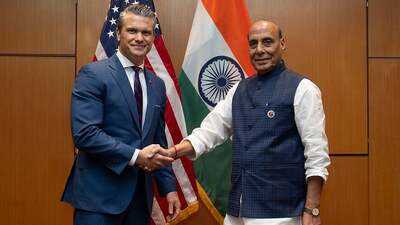India and the United States have signed a landmark 10-year framework agreement to expand cooperation in the defence sector, marking a major step forward in their strategic partnership and shared vision for a free and open Indo-Pacific region.
The pact was formalised during a meeting between defence minister Rajnath Singh and US defence secretary Peter Hegseth on the sidelines of the ASEAN-India Defence Ministers’ Informal Meeting in Kuala Lumpur.
Confirming the development, Mr Singh described the talks as “fruitful,” stating that the framework would provide policy direction for the entire spectrum of the India-US defence relationship.
“We signed the 10-year ‘Framework for the US-India Major Defence Partnership’. This will usher in a new era in our already strong defence partnership,” he said in a post on X.
He added that the agreement signifies India’s growing role in regional security and reflects the nations’ shared commitment to maintaining peace, stability, and a rules-based order in the Indo-Pacific. “Defence will remain a major pillar of our bilateral relations,” Mr Singh said.
Mr Hegseth echoed this sentiment, calling the framework a “cornerstone for regional stability and deterrence.” He noted, “We’re enhancing our coordination, information sharing, and technology cooperation. Our defence ties have never been stronger.”
The groundwork for the new framework was laid earlier this year during a phone conversation between Mr Singh and Mr Hegseth, where the decision was finalised. A Pentagon statement issued on 2 July confirmed the discussions, which focused on several key areas of bilateral defence cooperation.
The two sides discussed pending US defence sales to India and explored ways to deepen industrial collaboration under India’s Make in India initiative, aimed at boosting domestic manufacturing. A major point of discussion was the delay in the delivery of GE Aerospace’s F404 engines, crucial for the Tejas Light Combat Aircraft (LCA), which has impacted Hindustan Aeronautics Ltd (HAL)’s delivery schedule for the Indian Air Force.
Mr Singh also emphasised the early finalisation of a proposed agreement between HAL and GE Aerospace for the joint production of F414 engines in India, a project expected to enhance indigenous defence production and reduce dependency on imports.
US will continue to foster stronger defence partnership with India: PentagonI just met with @rajnathsingh to sign a 10-year U.S.-India Defense Framework.
— Secretary of War Pete Hegseth (@SecWar) October 31, 2025
This advances our defense partnership, a cornerstone for regional stability and deterrence.
We're enhancing our coordination, info sharing, and tech cooperation. Our defense ties have never been… pic.twitter.com/hPmkZdMDv2
Despite the strong momentum, the India-US 10-year defence framework faces several hurdles. Regulatory and bureaucratic complexities continue to slow joint projects and technology transfers. Stringent US export control regulations, particularly under the International Traffic in Arms Regulations (ITAR), limit India’s access to advanced defence technologies.
Conversely, India’s own bureaucratic red tape often delays foreign direct investment (FDI) approvals and hampers defence manufacturing collaboration.
Strategic misalignments also persist. While the US views India as a key partner in countering China’s regional influence, India continues to pursue an independent foreign policy, maintaining strategic ties with Russia, a stance complicated by its heavy reliance on Russian military hardware and potential exposure to US sanctions under the CAATSA law.
Cybersecurity threats from state-sponsored actors, differences in data protection frameworks, and a lack of harmonisation in cybersecurity protocols pose additional risks to technology sharing and intelligence exchange. Furthermore, domestic political shifts, changing US policy priorities, and public opinion in both countries could impact the long-term consistency of the framework.
For the framework to realise its full potential, experts emphasise the need for sustained diplomatic engagement, streamlined regulatory processes, and stronger cybersecurity measures. Aligning strategic priorities and ensuring bipartisan support in both nations will be critical to maintaining flexibility amid evolving geopolitical realities.
Equally important will be ensuring that the partnership genuinely strengthens India’s indigenous defence manufacturing ecosystem rather than fostering dependency on imports. If successfully implemented, the new framework could define the next decade of US-India defence cooperation transforming it into a model for strategic collaboration between major democracies in an increasingly uncertain world.
You may also like

'Rachel Reeves gone in six months' as Chancellor humiliated on GB News

Pocso FIR quashed: High court cites lawful marriage, peaceful family life

Tennis LIVE: Djokovic learns fate in new home as Sabalenka addresses behaviour

Fury over new free bus pass update as Labour branded 'disappointing'

Las Vegas Aces' star A'ja Wilson stuns fans with another nostalgic and creative Halloween transformation







